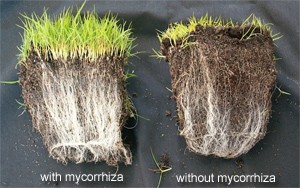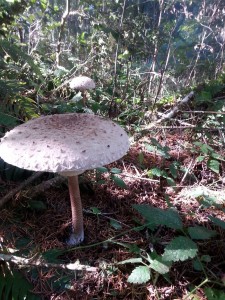^Above image (1.Fungi mycelium growing with plant roots in the ground)
[1]Fungi are the elusive organisms hidden within our environments, many of which are difficult to understand from the surface level. Fungi are the source of 90% of all decomposition that happens on our planet. They absorb nutrients and alter these substances into materials which nearly all of the other organisms depend on in some way. This conversion can be seen as the transfer of the cycle of death and decay back into life and new growth. One extremely important relation of this transfer of energy is determined by the group of fungi called mycorrhiza. This symbiosis is so vital in ecosystems that 95% of plant families have formed these relationships with the fungi and typically at very least with six different varieties per plant.
[2]Mother trees we see as very old trees. The oldest trees in forests have massive networks that connect to trees as far as you can see via mycelial bridges. This mycelium, the growth of filamentous fungal cells through soils and wood debris connect niches of plant communities in order to help the plants to capture water and give them vital plant nutrients such as phosphorus. This action is very special because it links plants and trees of different species into an exchange of materials through soil below for vast distances. In neural networks our brains are connected via axons and dendrites. The connections between these trees work as interfaces that move nutrients through the environments around them very similar to the way we create synapse to build diverse pathways so that different parts of our brains can communicate.
[3]This connection of plants, especially trees, and these fungi can be observed in extreme intricacy in areas that have been clear cut by timber industries. In her studies, Grace Sparks, noted that fewer fungi taxa were found in the clear cut areas with less diversity moving closer to the center of the harvest. Most of these species tended to be decomposers whereas deeper into the forest the most common fungi were mycorrhiza. The edge of the cut influenced growth of organisms from a range of 30-60 meters. Mycorrhiza obtain carbon from adult tree roots extending into clear cut areas. Adult trees near forest edges influenced fungal fruiting via water uptake from the edge soils surrounding. These areas do regenerate over time, however, Grace further mentions that maintaining a vast fungal diversity helps to ensure that fungi will continue to be able to adapt and fulfill their role in local landscape changes from industry or natural disasters.

2.Plants grow with fungi better than they do alone.
[4]A forests health is directly correlated to the presence and abundance of different mycorrhiza(see image above) and their relationships with plants. Mycelium in the first layers of topsoil in our Douglas fir dominant forests in the Pacific Northwest Bioregion reaches 10% of the bio mass. The filamentous weaving of the mycelial network grows through cell walls of plants and secrete acids and enzymes that break down debris around them similar to something akin to an externalized stomach. They digest the material returning carbon, nitrogen, hydrogen, and minerals back into the ecosystem in forms that insects, plants, mammals, and many other organisms can use and benefit from.
[4]In areas that have been disrupted by human intervention or storm surges, plants are damaged and the debris that scatters is in need of breaking down. Saprophytic fungi come into the picture in scenarios such as clear cuts. Some of these fungi are the trailblazers for repairing areas that are damaged. Others depend on primary decomposition for nutrients and take care of the more difficult compounds to break down such as lignin. They pave the way for tertiary decomposers which often piggy back after primary and secondary decomposers leaving them to begin their work as the finishers in the life of the leaves, wood, and other materials that reach the ground. It’s not surprising that some of the most common macro fungi seen by humans are these decomposers. They are reacting to our alterations to the environment and growing with our changes.
[5]It’s fascinating to learn about fungal infections such as heartwood rot. Heartwood rot is caused when trees have been colonized by fungi that feed on their dead inner tissue. As the tree is broken down from the inside, outside invaders enter. Ants and termites lead the burrowing beetles and grubs that follow. Many successions of fungi exist simultaneously with a multitude of organisms all considering the decaying tree their home and source of nourishment. Eventually whole branches will rot off leaving room for birds to nest and continued successions of life cycles until the tree finally is completely converted, decades after the infection, back down through the hyphal net of the mycelia below. Here the cycle is continued. The nutrients of the large tree were being dispersed among its neighbors since before the rot fungi was consuming it. As trees age, they naturally give off some of their nutrients to those saplings around them, ensuring a healthy future for the forest.
The mycorrhiza is always in contact, facilitating the movement of energy beneath the ground. It is aware of the vibrations of every step you take entering into the forest. As you walk, the mycelium runs, connecting those far off reaches with the very shoe upon your foot. Whispers of information are exchanged to each of the trees and plants surrounding. There is a realization, a stewardship, a willingness to take action and build bridges in these organisms. The molecular magicians bring death back to life creating conditions so that new habitats can form and the old heal from damage. Fungi are always ready to adapt and continue the cycle in which they mastered with hundreds upon millions of years of change.

3. Fungi are the mysterious connectors below and around. As you walk through the forest, they sense your movement and communicate it with organisms near and far.
Sources:
1. Trappe J. M. Phylogenetic and ecologic aspects of mycotrophy in the angiosperms from an evolutionary standpoint. Ecophysiology of VA Mycorrhizal Plants, G.R. Safir. [Publication] (EDS) Florida: CRC Press. 1988
2. Evert R.F. Eichhorn S.E. Raven P. H. Raven Biology of Plants. [Print] 2013
3. Sparks G. B. “Influence of Forest-clearcut Edges on Fungal Fruiting, Litter Decomposition and Seedling Growth in Low Elevation Second-growth Conifer Forests in Western Washington.” Diss. Abstract. [Print] 2003
4. Stamets P. Mycelium Running: How Mushrooms Can Help save the World. Berkeley, CA: Ten Speed. [Print] 2005
5. McCoy P. Radical Mycology: A Treatise on Seeing & Working with Fungi. [Print] 2016
Pictures:
1.Douglas H. Chadwick. http://www.motherearthnews.com/organic-gardening/gardening-techniques/mycorrhizal-fungi-zm0z14aszkin.aspx, 2014. Web.
2.Half Hill Farm. http://www.motherearthnews.com/organic-gardening/gardening-techniques/mycorrhizal-fungi-zm0z14aszkin.aspx. 2013.Web.
3.Picture of Lepiota procera by Daniel Gilberts off of Kamilche Point Road.

Leave a Reply